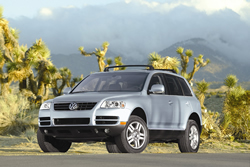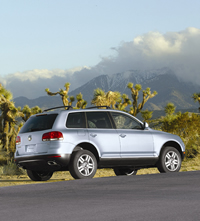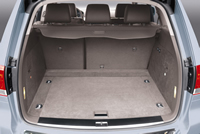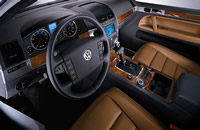 I
have no idea how long the woman, with husband and baby in tow, had been examining
my test Volkswagen Touareg sport utility vehicle. I
have no idea how long the woman, with husband and baby in tow, had been examining
my test Volkswagen Touareg sport utility vehicle.
All
I know is I came out to the parking lot, let her look inside at the Touareg's
sophisticated, wood and silver-colored trimmed interior, and that was it. She
oohed and ahhed, then pointed to her Dodge Durango and declared it now a trade-in
candidate. She didn't even ask the price! If only all Touareg sales could come
as easily.
This
first SUV from a German company best known for selling cars for the common people
is attracting attention — and awards.
Named the SUV
of the Year: Most Likely to Survive Anything by ROAD & TRAVEL Magazine
as well as 2004 SUV of the Year by Motor Trend magazine, the Touareg also is raising
eyebrows because of its rather high starting price of around $35,000. This
is akin to the starting price of some luxury SUVs, such as the Lexus RX 330 and
the Mercedes-Benz M-Class. For more nformation about the Touareg's ICOTY win, click here.
I
admit the price even surprised me. But
after test-driving the Touareg with a V8 and then a V6, I quickly came to appreciate
this well-proportioned SUV that eschews the brutish style of many American SUVs.
For
the record, the five-passenger, four-wheel-drive Touareg is pronounced "Tour-reg". It's named after a nomadic tribe in Africa.
The Touareg is not a barebones SUV. Standard equipment on
every model includes full-time four-wheel drive, power, glass sunroof, large wheels
and tires that are at least 17 inches in diameter, dual-zone, automatic climate
control, leather or "leatherette" seat trim, six-speed automatic transmission
with Tiptronic manumatic shifting, front, side and curtain airbags, traction control,
skid control, antilock brakes and hill descent assist.
 Beyond
all the equipment, the Touareg is not a small, cheap-feeling
SUV. It feels decidedly upscale and rides solidly. Beyond
all the equipment, the Touareg is not a small, cheap-feeling
SUV. It feels decidedly upscale and rides solidly.
I
suspect many folks moving from German sedans to SUVs or looking to leave their
truck-based SUVs for something more car-like will find the Touareg ride quite
pleasing. The
testers rode like touring sedans on pavement while providing rugged off-road capability.
The
Touareg is one of those rare sport utility vehicles where drivers can enjoy roads that have a lot
of curves, as the testers stuck to the pavement and snaked through back country
roads with zest and composure.
To
be sure, Touareg riders don't sit up as high as they might, say, in a Cadillac
Escalade. But there's still an elevated ride height here — enough that I could
see over cars and through the windows of minivans and some mid-sized SUVs that
were in front of me. I still couldn't see much around big trucks or full-size
SUVs.
The Touareg uses the same chassis that's in the more-expensive Porsche Cayenne, and there's a noticeable firmness to the ride. I and my passengers felt mild vibrations as we traveled, but there was no jarring or truckish bounciness, and the Touareg's body and considerable weight felt tightly controlled.
Front suspension here is independent, double wishbone. The rear has an independent four-link configuration. An air suspension package is optional. The V6 tester rode quite quietly on 17-inch, all-season tires. The test Touareg V8 had 18-inchers. The Touareg's power-assisted, rack-and-pinion steering was quite responsive, with just small inputs from the driver.
The 3.2-liter, double overhead cam, gasoline V6 offers up 220 horsepower and 225 lb-ft. of torque at 3,200 rpm. This was ample for city driving, however, when loaded with passengers and some cargo and headed for the mountains, the Touareg fared better with the uplevel, 4.2-liter, double overhead cam, gasoline V8. This bigger powerplant supplies 310 horsepower and 302 lb.-ft. of torque at 3,000 to 4,000 rpm.
Just arriving in calendar 2004 is the Touareg's third engine — a 310-horsepower, 5-liter, diesel V10 capable of an awesome 553 lb.-ft. of torque at a low 2,000 rpm.Fuel economy isn't the greatest, no matter which Touareg engine is installed. The V6 model is rated at only 15 miles a gallon in city driving and 20 mpg on the highway, for example. The V10 diesel model is rated at 17 mpg in city driving and 23 mpg on the highway.
 The cargo room at the back of the Touaregs was so nicely carpeted and accented by silver cargo hooks, it looked too pretty to put potted plants or other dirty things into. The cargo room at the back of the Touaregs was so nicely carpeted and accented by silver cargo hooks, it looked too pretty to put potted plants or other dirty things into.
And if you're prone to details, you might note that the Touareg has less cargo space than the VW Passat station wagon. With Touareg's rear seats in use, for example, there's just 19.6 cubic feet of storage space vs. 39 in the Passat wagon. With rear seats folded down, the Touareg's maximum cargo room is 55.4 cubic feet vs. 56.5 in the Passat wagon. But the Touareg's 9.4 inches of ground clearance and off-road-ready short overhangs, front and rear, help it go places the Passat wouldn't.
Drivers don't need to shift into four-wheel drive in the Touareg. It's on all the time, delivering half the power to the front axle and half to the back in normal conditions, and automatically can switch power between axles when needed. In fact, with the optional rear differential lock, which the driver engages in strenuous road conditions, up to all the power can be transferred to any wheel that still has traction.
 Note that the four-wheel-drive system in the Touareg is called 4XMotion and is different from the 4Motion all-wheel-drive system that's in some VW cars.Rear-seat riders should watch as they get in and out of the Touareg, as the sizable rear wheel wells are right at the doorway openings. Note that the four-wheel-drive system in the Touareg is called 4XMotion and is different from the 4Motion all-wheel-drive system that's in some VW cars.Rear-seat riders should watch as they get in and out of the Touareg, as the sizable rear wheel wells are right at the doorway openings.
And sometimes, it's difficult to tell if the rear doors are locked or unlocked. I often grabbed at the door handles outside, without realizing the doors were still locked.
Final notes: The Touareg isn't offered in two-wheel drive, and it doesn't come with third-row seating.
Click here for more information on the VW Touareg.
For the Volkswagen 2004 Model Guide : Click Here
|